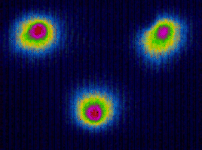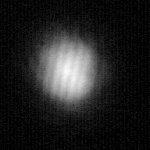Coupled lasers
Field of Research
Arrays of spatially coupled lasers, especially semiconductor laser arrays,
are of considerable technical importance for a number of applications.
For some purposes it is desirable that all lasers are synchronized in phase,
e.g., for the generation of high power coherent sources operating at a
stationary intensity. For other purposes, one may want to operate each
element of an array at its own variable power level, e.g., for display
applications or optical data processing. From a more fundamental point
of view, the study of coupled nonlinear oscillators reveals a fascinating
wealth of dynamical phenomena; here, coupled lasers -- or coupled modes
of one laser -- are systems well suited for theoretical and experimental
investigation of these phenomena.
Both experiment and theory have shown that already two single-mode
lasers that are stable individually can exhibit a chaotic instability when
coupled. Studying only two lasers can thus be considered a preliminary
step to the investigation of larger numbers of coupled lasers.
Neodymium-doped yttrium orthovanadate (Nd:YVO4)
is a fairly novel laser material that can provide much higher gain per
unit volume than the well-established materials like Nd:YAG. Using very
thin laser crystals (down to 100µm), so-called microchip or
microcavity
lasers can be created. Owing to the large mode spacing, these lasers can
operate on a single frequency without any additional selection elements.
Our studies involve a system of two or three coupled lasers in a semimonolithic
Nd:YVO4 microchip resonator, pumped by a titanium-sapphire
laser.
When the lasers are coupled, intensity instabilities occur that are
caused by the interaction between the phase dynamics and the intensity
dynamics. The instabilities can be synchronous oscillations or pulses of
the intensities of all lasers, or can strong oscillations in one laser
only (so called localized synchronization). In our experiments we observe
these phenomena and identify and classify their parameter regimes. The
experimental observations are compared to numerical simulations of suitable
dynamical models.
Experimental setup

|
Experimental setup
(click for larger image) |

|
Laser system (Detail)
(click for larger image)
|
Experimental Observations
The figures show a setup of three coupled lasers. Their distances are chosen
such that their mutual coupling strenghts are roughly equal. While the
near field is unchanged, different changes in the frequency detuning betwenn
the three lasers lead to different states of phase coupling, which can
be discriminated in the far field images: an uncoupled state (the gaussian
distribution shows the addition of the single-laser intensities), phase
coupling between two lasers (interference stripes) or the coupling of all
three lasers with relative phase differences of 120° (hexagonal pattern).

|
3 coupled lasers (near field) |

|
3 coupled lasers (far field) |
Team Members
- Dr. Bernd Forsmann
- Dr. Michael Möller
- Dipl.-Phys. Jens Schüttler
- Dipl.-Phys. Martin Janssen
- Dipl.-Phys. Andres Kornfeld
- Dipl.-Phys. Marcus Ch. Kutzborski
- Dipl.-Phys. Mark Schülke
Publications
-
K.S. Thornburg, Jr., M. Möller, R. Roy, T.W. Carr, R.-D. Li, and T.
Erneux
Chaos and Coherence in Coupled Lasers, Phys. Rev. E 55,
3856 (1997)
-
Bernd Forsmann
Aufbau und Untersuchungen eines Systems zweier gekoppelter Festkörper-Laser,Diplomarbeit
1997
-
M. Möller, B. Forsmann and W. Lange
Amplitude Instability in Coupled Nd:YVO4 Microchip Lasers, IQEC'98
conference (abstract) and EQEC'98 conference
(transparencies)
-
M. Möller, B. Forsmann and W. Lange
Instabilities in Coupled Nd:YVO4 Microchip Lasers, Quantum
Semiclass. Opt. 10, 839 (1998)
|

